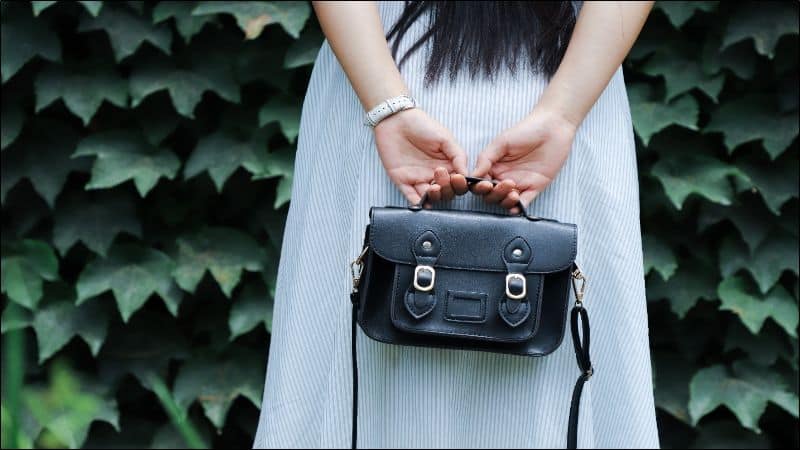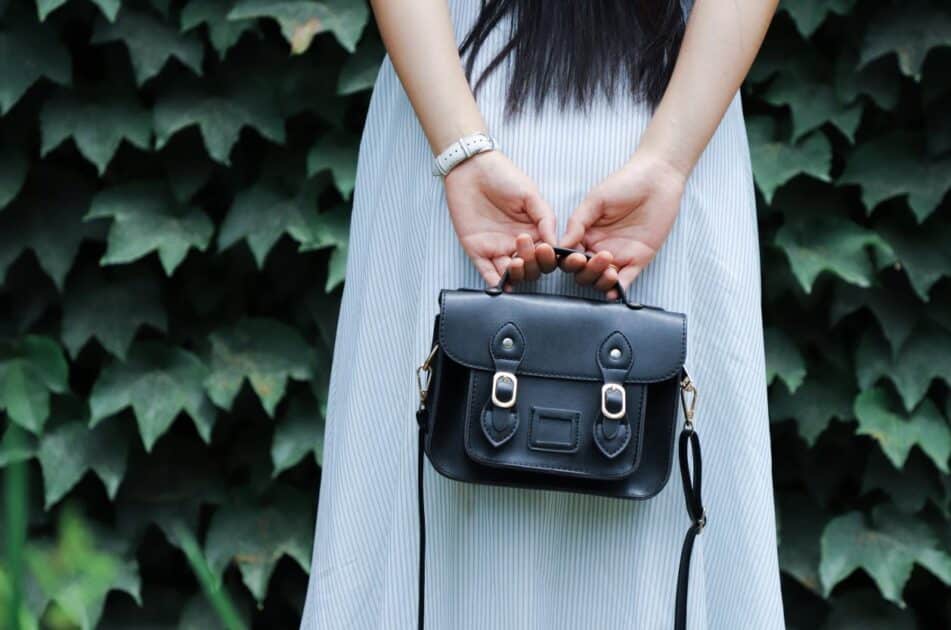Ever wondered who we have to thank for the convenience of handbags? These essential accessories didn’t just appear out of thin air. They have a creator, a history, and boy, is it a fascinating one!

Back in the day, both men and women needed something to carry their coins, herbs, and important trinkets. Enter the handbag’s ancestors—pouches and girdle bags. But who took the leap from practical pouch to the fashion-forward handbag you know and love?
The Origin of Handbags
Venturing back in time, you’ll discover that handbags are deeply rooted in history. The concept dates back to ancient civilizations. Egyptians carried pouches secured with a drawstring, while Babylonians used them to carry tokens during trade. Their function was clear: handbags were essential for toting everyday items.
In the Middle Ages, both men and women slung small bags over their belts. Crafted from leather or cloth, these bags weren’t just practical; they were status symbols too. The more intricate the design, the higher the social standing of the wearer. It’s intriguing to note that during the 15th century, a special bag called a “chaneries” was used to carry coins to the Chancery.
The 17th century propelled the handbag into the fashion sphere. As clothing styles changed, pockets disappeared from women’s dresses, sparking a need for reticules—small, decorative handbags. The industrial revolution then played a pivotal role, influencing handbag production. The introduction of railway travel necessitated durable handbags, leading to brands like Hermes stepping into the spotlight.
The modern handbag as we know it, however, emerged in the 20th century. Major fashion houses, including Louis Vuitton, Chanel, and Gucci, began designing luxury handbags that were both functional and fashionable. Their popularity soared, cementing handbags as an indispensable accessory in women’s fashion.
It’s difficult to pinpoint a single inventor of the modern handbag because it was more a progression than a sudden invention. Nonetheless, credit is often attributed to designers who revolutionized the concept. For instance, Louis Vuitton’s flat-bottomed trunks inspired his move into handbag design, while Coco Chanel’s introduction of the 2.55 bag in 1955 made a definitive impact.
While the exact genesis remains nebulous, there’s no doubt that creativity and functionality have shaped the handbag’s evolution. Countless designers have left indelible marks on the accessory that’s become a staple in closets around the world.
Pouches and Girdle Bags: The Ancestors of Handbags
Ancient civilizations did more than just build empires; they laid the groundwork for today’s fashion essentials. Think of the Egyptians and Babylonians who utilized pouches, precursors to what you now recognize as handbags. These pouches weren’t merely practical; they were personal totems adorned with precious stones and embroideries, signaling wealth and status.
Fast forward to the Middle Ages, and you’ll notice both men and women fastening girdle bags around their waists. This trend wasn’t just a medieval fashion statement; it was a necessity. With clothing lacking pockets, these girdle bags served as secure storage for everything from currency to small trinkets.
Key takeaways:
- Pouches and girdle bags were ancient accessories mounted on belts.
- Embellishments indicated social standing.
- Practicality drove the design, addressing the absence of pockets in garments.
The rise of girdle bags, particularly in the 14th and 15th centuries, aligned with the social and economic shifts of the time. As trade increased, so did the need for a safe place to carry coins. Leather and fabric were the go-to materials, often chosen for their durability and ease of craftsmanship.
Women’s girdle bags took on a more distinct form during the Tudor period. Elaborate and often jewel-encrusted, these items became so much more than a carrying device; they were a piece of the fashion ensemble. By the 17th century, as men’s fashion evolved to include pockets, women’s clothing did not, leading to the innovation and increased popularity of the small, handheld reticule.
Let’s drill down on another pivotal moment: the Renaissance era. Craftsmanship flourished, and so did the variety of bags. Materials expanded to include velvet and silk, while designs grew more ornate. Remember, it was during this period that bags became personalized artworks, each telling their own story not just through their form, but through their design narrative.
In the grand tapestry of handbag history, these early forms play a critical role. Not just as practical solutions or status symbols but as the creative spark that fueled the evolution to what you sling over your shoulder or clutch in your hand today.
The Evolution of Handbags
As a handbag enthusiast and expert, you’ll appreciate knowing how these accessories have metamorphosed over time. The changes weren’t just in form but also in the functionality and symbolism associated with them.
During the Industrial Revolution, a significant shift occurred. Mass production kicked in. This era was crucial as it allowed handbags to be more accessible. Affordability became key and women from various social classes could now own a handbag. Different styles like the coin purse and the chatelaine were popular, with materials ranging from leather to metals.
Travel influenced the evolution of handbags too. In the late 19th and early 20th centuries, steam travel necessitated a new type of bag: luggage. Trunks and suitcases by brands like Louis Vuitton set the groundwork for the modern handbag, introducing elements of luxury and design that are still celebrated today.
Post World War II marked another leap. The rise of youth culture and fashion brought about the need for casual and sporty handbags. This era saw the introduction of materials like nylon and plastic, reflecting a world embracing new technologies.
« Can You Put Handbags in the Washing Machine? Secrets to Safely Clean Your Purse
How to Soften a Vinyl Handbag for a Supple Feel & Lasting Care »
The late 20th century witnessed a fusion of Functionality and Fashion. Designer brands like Chanel and Hermès set the tone for handbags as a status symbol, catering to the desires of both fashion-forward individuals and professionals. Structures became more sophisticated. Backpacks, messenger bags, and totes emerged, responding to the demands of a mobile lifestyle.
Let’s not forget Cultural Influences. Handbags took cues from art, music, and even politics. They became a canvas for self-expression and a medium for artists and designers to leave their mark.
Your knowledge of the history of handbags isn’t just about dates and materials. It’s about understanding the connection between society’s evolution and the accessories it carries. Every stitch and buckle has a story that speaks to the trends and needs of its time.
A New Era: The Fashion-Forward Handbag
You’ve seen how handbags evolved from purely functional items to symbols of status and style. In the fashion-forward era, they’re not just accessories; they’re statement pieces. As a handbag enthusiast, you know that this transformation didn’t happen overnight.
Designer Influence took center stage in the late 20th century. Brands like Louis Vuitton, Chanel, and Hermès weren’t just manufacturing bags; they were crafting legacies. Their influence turned handbags into high-end must-haves. You’ve probably coveted at least one of these iconic designs.
- The Birkin and the Kelly, for example, became instant classics due not only to their design but also their exclusivity.
- Chanel’s Flap Bag revolutionized the use of shoulder straps, becoming a staple in the wardrobes of the rich and famous.
As styles diversified, so did the materials used. The influx of leather, suede, and exotic skins gave consumers a plethora of choices. You appreciate the variety, knowing that the right material can instantly elevate a bag’s look.
Collaborations between high fashion designers and streetwear brands blurred the lines of luxury. You’ve noticed how brands like Supreme and Off-White have redefined what’s considered high-end by partnering with traditional luxury houses.
Technology also made its mark on handbag design, introducing smart features like built-in chargers and GPS trackers. This innovation reflects your modern, on-the-go lifestyle, merging tech with fashion seamlessly.
Fashionistas like you are always on the lookout for limited editions and unique collections. These pieces often become the talk of the season, and you know snagging one is a sprint against time and demand.
The story of the handbag is ongoing. Trends emerge, designers experiment, and you’re there to witness it all. As new designs roll out, you’re ready to see how these will shape the handbags of tomorrow. Perhaps the next iconic bag is just around the corner, waiting to be part of fashion history.
Conclusion
You’ve journeyed through the fascinating evolution of handbags from pure necessity to the epitome of style and luxury. You’ve seen how icons like the Birkin and Kelly have set the bar high for what a handbag can represent. As you’ve learned, the story of handbags is far from over. With technology stepping in and the lines between high fashion and streetwear continuing to blur, you’re in for an exciting future. Stay tuned to see how handbags will continue to evolve, surprise, and delight fashion enthusiasts around the world. Keep an eye out, because what’s next might just redefine your idea of the perfect accessory.
Frequently Asked Questions
What is the history of handbags?
Handbags began as functional items but have evolved into fashion statements due to the influence of designer brands like Louis Vuitton, Chanel, and Hermès.
How did designer brands affect handbags?
Designer brands transformed handbags into high-end must-haves, with iconic designs like the Birkin and the Kelly bag becoming symbols of luxury and style.
What materials are commonly used in handbags?
Common materials for handbags include leather, suede, and exotic skins, chosen for their durability and aesthetic appeal.
How have collaborations influenced handbag designs?
Collaborations between high fashion designers and streetwear brands have blurred the lines between luxury and casual, introducing unique styles to the handbag market.
What impact has technology had on handbag design?
Technology has introduced smart features to handbags, such as built-in chargers and trackers, enhancing their functionality for modern users.
What can be expected for the future of handbag designs?
The handbag story is ongoing, with an anticipation for innovative designs that merge style, functionality, and technology.










